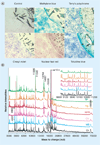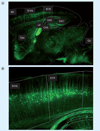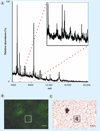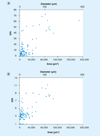Recent advances in single-cell MALDI mass spectrometry imaging and potential clinical impact
- PMID: 21999830
- PMCID: PMC3268336
- DOI: 10.1586/epr.11.53
Recent advances in single-cell MALDI mass spectrometry imaging and potential clinical impact
Abstract
Single-cell analysis is gaining popularity in the field of mass spectrometry as a method for analyzing protein and peptide content in cells. The spatial resolution of MALDI mass spectrometry (MS) imaging is by a large extent limited by the laser focal diameter and the displacement of analytes during matrix deposition. Owing to recent advancements in both laser optics and matrix deposition methods, spatial resolution on the order of a single eukaryotic cell is now achievable by MALDI MS imaging. Provided adequate instrument sensitivity, a lateral resolution of approximately 10 µm is currently attainable with commercial instruments. As a result of these advances, MALDI MS imaging is poised to become a transformative clinical technology. In this article, the crucial steps needed to obtain single-cell resolution are discussed, as well as potential applications to disease research.
Figures








Similar articles
-
Recent advancements in matrix-assisted laser desorption/ionization mass spectrometry imaging.Curr Opin Biotechnol. 2017 Feb;43:62-69. doi: 10.1016/j.copbio.2016.09.003. Epub 2016 Sep 28. Curr Opin Biotechnol. 2017. PMID: 27690313 Review.
-
Cellular resolution in clinical MALDI mass spectrometry imaging: the latest advancements and current challenges.Clin Chem Lab Med. 2020 Jun 25;58(6):914-929. doi: 10.1515/cclm-2019-0858. Clin Chem Lab Med. 2020. PMID: 31665113 Free PMC article. Review.
-
MALDI imaging mass spectrometry for direct tissue analysis: technological advancements and recent applications.Histochem Cell Biol. 2011 Sep;136(3):227-44. doi: 10.1007/s00418-011-0843-x. Epub 2011 Jul 30. Histochem Cell Biol. 2011. PMID: 21805154 Review.
-
A high resolution atmospheric pressure matrix-assisted laser desorption/ionization-quadrupole-orbitrap MS platform enables in situ analysis of biomolecules by multi-mode ionization and acquisition.Anal Chim Acta. 2018 May 12;1007:16-25. doi: 10.1016/j.aca.2017.12.045. Epub 2018 Jan 6. Anal Chim Acta. 2018. PMID: 29405984 Free PMC article.
-
Direct imaging of single cells and tissue at sub-cellular spatial resolution using transmission geometry MALDI MS.J Mass Spectrom. 2012 Nov;47(11):1473-81. doi: 10.1002/jms.3108. J Mass Spectrom. 2012. PMID: 23147824
Cited by
-
Using Dicationic Ion-Pairing Compounds To Enhance the Single Cell Mass Spectrometry Analysis Using the Single-Probe: A Microscale Sampling and Ionization Device.Anal Chem. 2016 Jul 5;88(13):6812-9. doi: 10.1021/acs.analchem.6b01284. Epub 2016 Jun 14. Anal Chem. 2016. PMID: 27239862 Free PMC article.
-
Metabolic Comparison of Dorsal versus Ventral Cells Directly in the Live 8-cell Frog Embryo by Microprobe Single-cell CE-ESI-MS.Anal Methods. 2017 Sep 14;9(34):4964-4970. doi: 10.1039/C7AY00834A. Epub 2017 May 9. Anal Methods. 2017. PMID: 29062391 Free PMC article.
-
Label-free molecular imaging of the kidney.Kidney Int. 2017 Sep;92(3):580-598. doi: 10.1016/j.kint.2017.03.052. Epub 2017 Jul 24. Kidney Int. 2017. PMID: 28750926 Free PMC article. Review.
-
A vision for better health: mass spectrometry imaging for clinical diagnostics.Clin Chim Acta. 2013 May;420:11-22. doi: 10.1016/j.cca.2012.10.018. Epub 2012 Oct 15. Clin Chim Acta. 2013. PMID: 23078851 Free PMC article. Review.
-
High-resolution MALDI mass spectrometric imaging of lipids in the mammalian retina.Histochem Cell Biol. 2015 May;143(5):453-62. doi: 10.1007/s00418-014-1303-1. Epub 2014 Dec 23. Histochem Cell Biol. 2015. PMID: 25534592
References
-
- McCombie G, Staab D, Stoeckli M, Knochenmuss R. Spatial and spectral correlations in MALDI mass spectrometry images by clustering and multivariate analysis. Anal. Chem. 2005;77(19):6118–6124. - PubMed
-
- Deininger SO, Ebert MP, Futterer A, Gerhard M, Rocken C. MALDI imaging combined with hierarchical clustering as a new tool for the interpretation of complex human cancers. J. Proteome Res. 2008;7(12):5230–5236. - PubMed
-
- Monroe EB, Jurchen JC, Lee J, Rubakhin SS, Sweedler JV. Vitamin E imaging and localization in the neuronal membrane. J. Am. Chem. Soc. 2005;127(35):12152–12153. - PubMed
Publication types
MeSH terms
Substances
Grants and funding
LinkOut - more resources
Full Text Sources
Other Literature Sources
Research Materials
